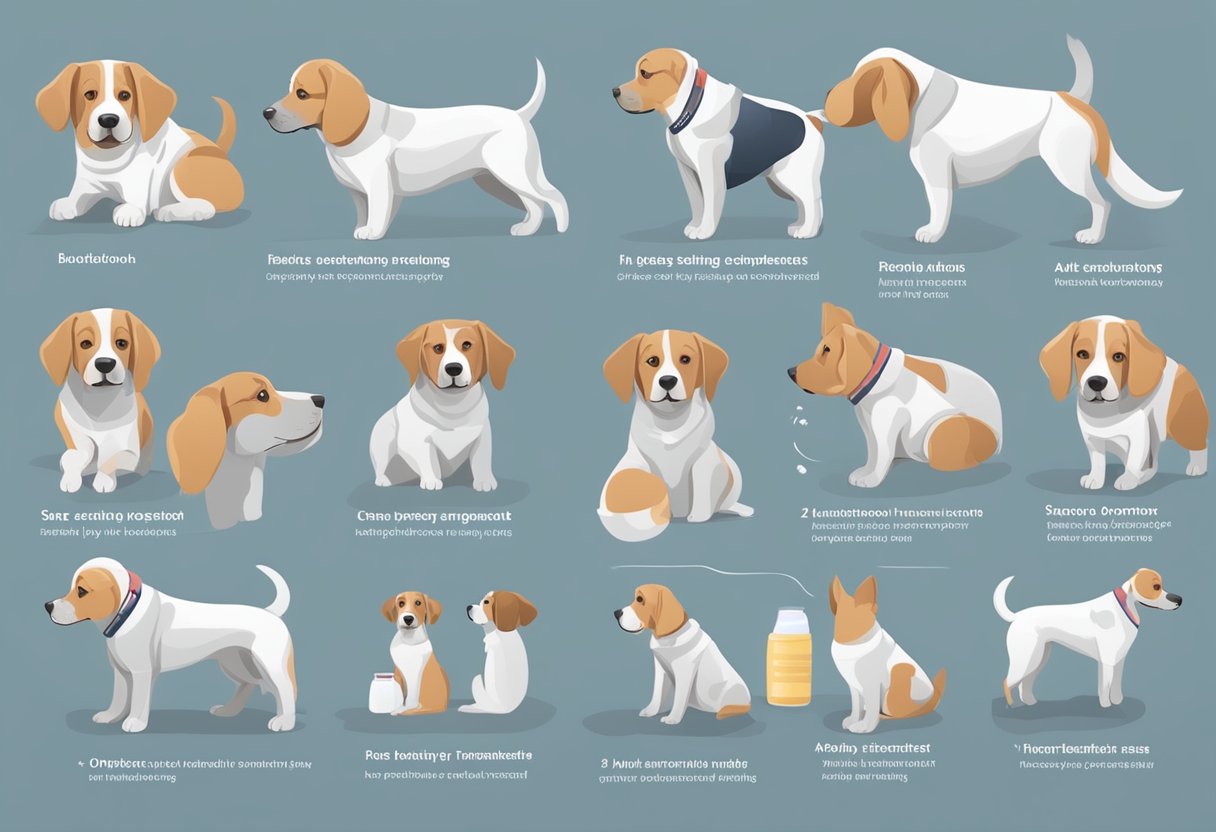LifeWithMyDogs is supported by our audience. When you purchase through one of our links, we may earn a small affiliate commission. As an Amazon Associate I earn from qualifying purchases. Your cost is not affected.
**********
Dogs often suffer from ear problems that can affect their happiness and health. Thus, identifying the signs early can lead to quicker treatment and less discomfort for your furry friend. Common ear problems in dogs may present varied symptoms. Still, veterinarians and pet owners widely recognize several signs, such as whining, persistent scratching, head shaking, and a foul odor emanating from the ears. These are usually the first indicators of an ear issue in your dog.
Signs of Common Ear Problems in Dogs: Identification and Prevention Tips

Knowing the characteristics of your dog’s ears when they are healthy will help you recognize when something is off. Normal dog ears should be clean, free of excessive wax or debris, and not emit any foul odor.
Any deviation from this, such as swelling, redness, or discharge, should prompt closer attention. These symptoms can escalate quickly if left untreated, leading to more severe consequences, such as hearing loss.
Key Takeaways
- Early recognition of ear problems can improve outcomes for dogs.
- Normal ears are clean and odor-free; alterations may signal issues.
- Prompt attention to symptoms can prevent more severe complications.
Recognizing Ear Problems in Dogs

When you’re looking to identify ear problems in your dog, there are vital signs you can watch for that may indicate an issue. These symptoms could suggest an infection, parasites, allergies, or other medical concerns requiring attention.
Monitor symptoms such as:
- Excessive scratching or pawing at the ears or head
- Frequent head shaking as though trying to remove something irritating
- Redness or swelling inside the ear, hence signaling inflammation
- An unpleasant odor emanating from the ears, which could suggest an infection
- Discharge that might look waxy, bloody, or pus-like, often found in bacterial or fungal infections
- Yelping or showing signs of pain when the ears are touched
- Noticeable changes in behavior, such as lethargy or aggression, could be a reaction to the discomfort
If your dog displays any of these symptoms, it’s crucial for their wellbeing to consult your vet. They can provide an examination and determine if treatments like medication or ear cleaning are necessary.
Remember, ear problems can worsen without proper care, potentially leading to more severe health issues, including hearing loss. Therefore, early recognition and treatment are crucial for maintaining your dog’s ear health.
Common Symptoms of Ear Issues

When your dog is dealing with ear problems, they may exhibit a range of signs indicating discomfort or infection. Pay attention to the following common symptoms such as:
- Whining or yelping: You might notice your dog is more vocal due to the discomfort or pain in their ear.
- Scratching: An increased scratching at their ears or around the area could suggest an issue.
- Head shaking: Frequent and vigorous shaking of the head is a typical sign of ear discomfort.
- Redness or swelling: The skin within the ear may appear red and swollen.
- Discharge: An unusual buildup of waxy, brown, or bloody material might be visible in the ear canal.
- Odor: A foul or yeasty smell emanating from the ears strongly indicates possible infection.
Odor and discharge are signs of ear infections and should be taken seriously. If you observe these symptoms, you will need to consult your veterinarian right away.
They can offer a definitive diagnosis and appropriate treatment plan, including cleaning, medication, or other interventions. Early detection and treatment can prevent more severe complications.
Regularly checking your dog’s ears during grooming can help identify these symptoms early. If you need help with what to look for or have concerns, your vet can demonstrate how to examine your dog’s ears and maintain their health properly.
Causes of Ear Problems in Dogs

Understanding the various causes of ear problems in dogs is crucial for prevention and treatment. Here are some common factors that contribute to ear conditions in canines.
Parasitic Infections
Ear mites are a common cause of ear problems, especially in puppies. These tiny parasites can cause intense itchiness and lead to secondary infections if not treated.
Bacterial Infections
Your dog’s ear environment can be conducive to bacterial growth, mainly if moisture is present. This can cause painful infections that require antibiotic treatment.
Yeast Infections
A yeasty odor from your dog’s ears often signifies a yeast infection. Dark, waxy discharge is another indicator of this condition, brought on by an overgrowth of fungus.
Allergies
Allergic reactions can lead to ear inflammation and infection. Your dog may be sensitive to environmental factors such as pollen or specific food ingredients, resulting in ear issues.
Foreign Bodies
Grass awns, ticks, and other foreign objects can become lodged in your dog’s ear canal. It’s essential to check their ears regularly to avoid complications from these intruders.
Hormonal Imbalances
Imbalances in hormones like thyroid hormone can influence skin and ear health, leading to abnormal conditions within the ear.
Hereditary Conditions
Certain breeds are prone to hereditary conditions that affect ear health. For example, cocker spaniels often suffer from genetic predispositions to chronic ear infections.
Diagnosis of Ear Problems

When diagnosing ear problems in your dog, veterinarians typically follow a structured approach involving a physical examination, laboratory testing, and imaging techniques.
Physical Examination
Your vet will start with an in-depth physical examination of your dog’s ears. This includes inspecting the ear canal and eardrum for redness, swelling, discharge, or foreign objects. A magnifying instrument called an otoscope might be used to get a detailed view of the ear canal and eardrum.
Laboratory Testing
Laboratory testing usually follows a physical exam. Your vet may take a sample of ear discharge and perform cytology, which examines the sample under a microscope to detect bacteria, yeast, or parasites. Culture and sensitivity tests may also be done to find the microorganisms causing the infection and their antibiotic susceptibility.
Imaging Techniques
In some cases, imaging techniques such as X-rays or a CT scan are necessary to diagnose deeper issues in the ear structure or to detect chronic or advanced ear disease. These techniques give a clearer picture of your dog’s ear canals and middle ear, which is critical for proper treatment planning.
Treatment Options for Ear Conditions

When your dog suffers from an ear condition, timely and appropriate treatment is crucial. Here are several methods available to address ear problems in dogs, ranging from medications to dietary adjustments.
Medications
- Antibiotics: If the ear infection is bacterial, your vet may prescribe antibiotic ear drops or oral medications.
- Antifungals: For yeast infections, antifungal treatments are effective.
- Steroids: To reduce inflammation and discomfort, steroids can be used, sometimes in combination with antibiotics or antifungals.
Surgery
- Ear Hematomas: Surgical intervention may be required for severe cases like ear hematomas.
- Chronic Infections: For dogs with recurrent issues, surgical alteration of the ear canal can increase airflow and reduce infection risk.
Home Remedies
- Regular Ear Cleaning: Gently cleaning your dog’s ears with a vet-recommended cleaner can prevent buildup.
- Eco-friendly Solutions: A vet may suggest specific home remedies, such as a mixture of water and apple cider vinegar, for its antiseptic properties.
Dietary Changes
- Omega-3 Fatty Acids: Adding omega-3 supplements to your dog’s diet can support skin health and reduce ear inflammation.
- Limited Ingredient Diets: Switching to a limited ingredient diet might help if the ear condition is related to allergies.
Choosing the proper treatment depends on the underlying cause of the ear condition. Please always consult your vet before you begin any treatment regimen.
Preventing Ear Problems in Dogs

Keeping your dog’s ears healthy is crucial for their overall well-being. Here are some practical steps you can take to prevent ear problems in dogs:
- Routine Checks: Regularly inspect your dog’s ears for signs of redness, discharge, or odor. Early detection can prevent many ear conditions from worsening.
- Proper Ear Cleaning: Learn how to safely clean your dog’s ears. Use vet-approved ear cleaning solutions and avoid inserting anything deep into the ear canal.
- Drying Ears: After baths or swimming, gently dry your dog’s ears to prevent moisture buildup, which can lead to infections.
- Hair Trimming: For breeds with excess ear hair, carefully trim the hair to promote air circulation. Consulting a professional groomer or veterinarian is advisable.
- Diet and Allergies: Monitor your dog’s diet, as allergies often manifest with ear issues. Speak to your vet about hypoallergenic diets if necessary.
- Parasite Prevention: Use prescribed flea and tick preventatives since parasites can cause ear irritation.
| Checklist | Action Item |
|---|---|
| Weekly | Inspect ears for unusual signs. |
| Monthly | Clean ears with approved methods. |
| Post-bathing | Dry ears thoroughly. |
| As needed | Trim ear hair for better airflow. |
| Ongoing | Monitor diet and manage allergies. |
Adhering to these preventive measures can significantly reduce the risk of ear problems in your furry friend. Remember to consult your veterinarian for personalized advice for your dog’s needs.
When to See a Veterinarian

Identifying signs of ear problems in your dog early can be crucial for preventing more serious complications. You should visit your veterinarian if you see symptoms such as:
- Persistent Scratching or Pawing at the ear or surrounding area.
- Head-shaking that seems excessive or unusual.
- Redness or swelling in the ear.
- Unpleasant Odor coming from the ear(s).
- Discharge that may be yellow, brown, or bloody.
- Visible Pain when the ear is touched.
- Hearing Loss if your dog is unresponsive to commands or noises.
The following table outlines scenarios that necessitate a veterinary examination:
| Symptom | Action Required |
|---|---|
| Mild wax buildup | Monitor at home; clean with canine ear cleaner if needed. |
| Excessive head shaking or scratching | Schedule a vet visit promptly. |
| Ear discharge or foul odor | See your vet immediately. |
| Behavioral changes like lethargy or aggression | Urgent veterinary attention is required. |
If you observe any growths or wounds, seeking veterinary care is essential as these signs may indicate more severe conditions such as infections or tumors.

Indeed, a prompt response can significantly affect your dog’s comfort and health. It’s better to err on the side of caution and have your veterinarian evaluate your dog’s symptoms, possibly preventing a minor issue from becoming more serious.
Video Credit: @DogsNaturallyMagazineDNM
Wrapping It Up
Identifying and preventing ear problems in dogs is essential. Watch for signs like scratching or redness. Keep ears clean and dry.
Regular vet check-ups help catch issues early. A healthy diet also supports ear health.
Remember, early attention can prevent bigger problems. Care for your dog’s ears for their overall well-being.
Frequently Asked Questions
How can I recognize the symptoms of an ear infection in my dog?
You might notice symptoms such as head shaking, scratching, redness, discharge, foul odor, or sensitivity around your dog’s ears, indicating an ear infection.
What are the differences in signs between yeast and bacterial ear infections in dogs?
A yeast ear infection typically has a distinct, musty odor and a brown, waxy discharge, whereas bacterial infections might produce a yellowish or greenish pus-like discharge.
What home remedies are safe for treating my dog’s ear problems?
Safe home remedies might include cleaning with a gentle dog ear cleaner or using natural products like apple cider vinegar diluted with water. However, always consult your vet before starting any home treatment.
What behavioral changes might I observe in my dog if it has an ear infection?
Behavior changes in your dog due to an ear infection can include excessive head shaking, scratching, and a decrease in playful behavior due to pain or discomfort.
When is it necessary to consult a veterinarian for a dog’s ear infection?
It’s crucial to consult a veterinarian for an ear infection, especially if symptoms persist or worsen, to prevent potential hearing loss or more severe complications.
What could be why my dog repeatedly gets ear infections in one ear?
Chronic ear infections in one ear could be due to underlying issues such as allergies, hormonal imbalances, or anatomical abnormalities that need to be addressed by a professional.
Learn More About Dog Care!
Discover gadgets like this that simplify your life with dogs. Find tools for easier, more enjoyable pet care. Unlock essential dog care tips with us. Join our Facebook, Instagram, and Twitter for practical advice, real stories, and a community focused on better dog care.
Facebook: https://www.facebook.com/1LWMD/
Instagram: http://instagram.com/lifewithmydogs2
Twitter : https://twitter.com/LifeWithMyDogs9
Learn more tips about dog care and more with us – where every dog’s health is a priority.


